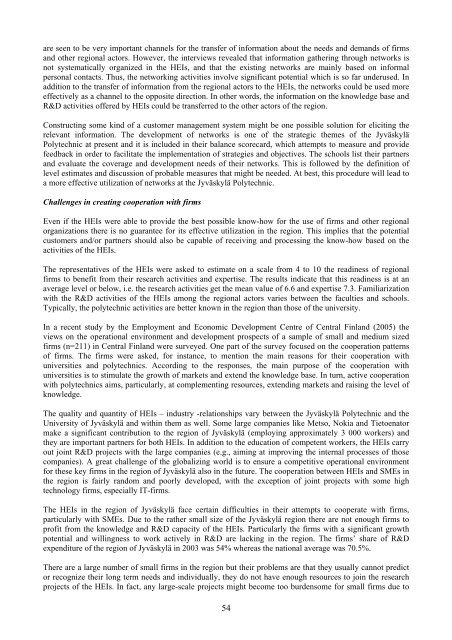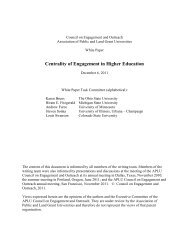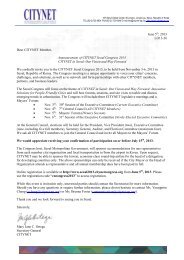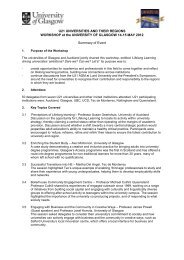Finland - Jyvaskyla Region - Final Self-Evaluation Report.pdf
Finland - Jyvaskyla Region - Final Self-Evaluation Report.pdf
Finland - Jyvaskyla Region - Final Self-Evaluation Report.pdf
You also want an ePaper? Increase the reach of your titles
YUMPU automatically turns print PDFs into web optimized ePapers that Google loves.
are seen to be very important channels for the transfer of information about the needs and demands of firmsand other regional actors. However, the interviews revealed that information gathering through networks isnot systematically organized in the HEIs, and that the existing networks are mainly based on informalpersonal contacts. Thus, the networking activities involve significant potential which is so far underused. Inaddition to the transfer of information from the regional actors to the HEIs, the networks could be used moreeffectively as a channel to the opposite direction. In other words, the information on the knowledge base andR&D activities offered by HEIs could be transferred to the other actors of the region.Constructing some kind of a customer management system might be one possible solution for eliciting therelevant information. The development of networks is one of the strategic themes of the JyväskyläPolytechnic at present and it is included in their balance scorecard, which attempts to measure and providefeedback in order to facilitate the implementation of strategies and objectives. The schools list their partnersand evaluate the coverage and development needs of their networks. This is followed by the definition oflevel estimates and discussion of probable measures that might be needed. At best, this procedure will lead toa more effective utilization of networks at the Jyväskylä Polytechnic.Challenges in creating cooperation with firmsEven if the HEIs were able to provide the best possible know-how for the use of firms and other regionalorganizations there is no guarantee for its effective utilization in the region. This implies that the potentialcustomers and/or partners should also be capable of receiving and processing the know-how based on theactivities of the HEIs.The representatives of the HEIs were asked to estimate on a scale from 4 to 10 the readiness of regionalfirms to benefit from their research activities and expertise. The results indicate that this readiness is at anaverage level or below, i.e. the research activities get the mean value of 6.6 and expertise 7.3. Familiarizationwith the R&D activities of the HEIs among the regional actors varies between the faculties and schools.Typically, the polytechnic activities are better known in the region than those of the university.In a recent study by the Employment and Economic Development Centre of Central <strong>Finland</strong> (2005) theviews on the operational environment and development prospects of a sample of small and medium sizedfirms (n=211) in Central <strong>Finland</strong> were surveyed. One part of the survey focused on the cooperation patternsof firms. The firms were asked, for instance, to mention the main reasons for their cooperation withuniversities and polytechnics. According to the responses, the main purpose of the cooperation withuniversities is to stimulate the growth of markets and extend the knowledge base. In turn, active cooperationwith polytechnics aims, particularly, at complementing resources, extending markets and raising the level ofknowledge.The quality and quantity of HEIs – industry -relationships vary between the Jyväskylä Polytechnic and theUniversity of Jyväskylä and within them as well. Some large companies like Metso, Nokia and Tietoenatormake a significant contribution to the region of Jyväskylä (employing approximately 3 000 workers) andthey are important partners for both HEIs. In addition to the education of competent workers, the HEIs carryout joint R&D projects with the large companies (e.g., aiming at improving the internal processes of thosecompanies). A great challenge of the globalizing world is to ensure a competitive operational environmentfor these key firms in the region of Jyväskylä also in the future. The cooperation between HEIs and SMEs inthe region is fairly random and poorly developed, with the exception of joint projects with some hightechnology firms, especially IT-firms.The HEIs in the region of Jyväskylä face certain difficulties in their attempts to cooperate with firms,particularly with SMEs. Due to the rather small size of the Jyväskylä region there are not enough firms toprofit from the knowledge and R&D capacity of the HEIs. Particularly the firms with a significant growthpotential and willingness to work actively in R&D are lacking in the region. The firms’ share of R&Dexpenditure of the region of Jyväskylä in 2003 was 54% whereas the national average was 70.5%.There are a large number of small firms in the region but their problems are that they usually cannot predictor recognize their long term needs and individually, they do not have enough resources to join the researchprojects of the HEIs. In fact, any large-scale projects might become too burdensome for small firms due to54










